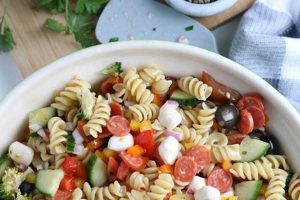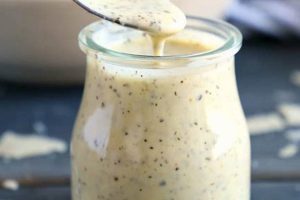Plant-based emulsified sauces for salads encompass a wide range of flavors and textures, from creamy cashew-based dressings to tangy citrus vinaigrettes. For example, a simple lemon-tahini dressing requires only tahini, lemon juice, water, and seasonings, blended until smooth. These culinary creations offer diverse options for enhancing fresh produce while adhering to a plant-based diet.
Creating flavorful, plant-forward meals often hinges on dressings that complement, rather than mask, the natural flavors of vegetables. These recipes provide essential building blocks for healthful, vibrant meals, contributing to a balanced and nutritious diet. The growing interest in plant-based diets has spurred innovation in this culinary area, leading to a resurgence of traditional techniques and the development of exciting new flavor combinations.
The following sections will explore various categories of plant-based salad dressings, including nut-based, seed-based, fruit-based, and herb-based options. Specific recipes and preparation techniques will be provided, along with suggestions for ingredient substitutions and pairing recommendations.
Tips for Crafting Delicious Plant-Based Salad Dressings
Achieving optimal flavor and texture in plant-based salad dressings requires attention to detail and a willingness to experiment. The following tips offer guidance for creating exceptional dressings.
Tip 1: Embrace the Power of Soaking: Soaking nuts and seeds before blending creates a smoother, creamier texture. Cashews, for example, benefit from soaking for at least two hours, or overnight, for optimal creaminess.
Tip 2: Balance Flavor Profiles: A harmonious balance of sweet, sour, salty, and savory elements is essential. A touch of maple syrup can balance the acidity of vinegar, while a pinch of salt enhances overall flavor.
Tip 3: Utilize Fresh Herbs and Spices: Freshly chopped herbs and spices elevate dressings beyond the ordinary. Consider using dill, parsley, mint, cilantro, or combinations thereof, to add depth and complexity.
Tip 4: Adjust Consistency as Needed: Desired consistency can be achieved by adding water, a tablespoon at a time, until the desired texture is reached. Thicker dressings cling better to greens, while thinner dressings offer a lighter touch.
Tip 5: Explore Flavor Combinations: Experiment with different flavor combinations, such as roasted red pepper and walnut, or miso and ginger. The possibilities are endless.
Tip 6: Proper Storage is Key: Store dressings in airtight containers in the refrigerator for up to five days. Allow dressings to come to room temperature before serving for optimal flavor.
Tip 7: Consider Nutritional Yeast: Nutritional yeast adds a cheesy, savory flavor to dressings and can be a valuable source of B vitamins.
By following these tips, one can create exceptional plant-based salad dressings that enhance any salad.
The versatility and nutritional benefits of plant-based salad dressings make them an essential component of any health-conscious kitchen. Experimentation with diverse flavors and textures can lead to exciting culinary discoveries.
1. Plant-based Ingredients
Plant-based ingredients are fundamental to vegan salad dressing recipes. These ingredients provide the foundation for flavor, texture, and nutritional value. The reliance on plant-based components necessitates careful consideration of ingredient combinations and preparation techniques to achieve desirable outcomes. For example, cashews, when soaked and blended, create a creamy base for dressings, while sunflower seeds offer a lighter, nuttier alternative. Acids, such as lemon juice or apple cider vinegar, provide brightness and tang, balancing the richness of other components. The thoughtful selection and utilization of plant-based ingredients directly influence the overall quality and character of the dressing.
Practical applications of this understanding are readily apparent in recipe development. A recipe for a creamy avocado dressing might incorporate avocado, lime juice, cilantro, and water. The avocado provides a healthy fat base, while the lime juice offers acidity and the cilantro adds a fresh herbal note. Similarly, a vinaigrette might feature a combination of olive oil, balsamic vinegar, Dijon mustard, and maple syrup. In this case, the olive oil provides a smooth texture, the balsamic vinegar lends tartness, the Dijon mustard adds complexity, and the maple syrup provides a touch of sweetness. These examples illustrate how various plant-based ingredients contribute specific properties to the final product.
Mastery of plant-based ingredients is essential for crafting successful vegan salad dressings. Understanding the individual characteristics of each ingredient, and how they interact with one another, allows for the creation of complex and flavorful dressings. This knowledge empowers culinary exploration and facilitates the development of innovative recipes, enhancing the enjoyment and nutritional value of plant-based cuisine. The increasing availability and variety of plant-based ingredients continue to expand the possibilities within this culinary domain.
2. Flavor Balance
Flavor balance is paramount in crafting successful vegan salad dressings. A well-balanced dressing complements, rather than overwhelms, the flavors of the salad ingredients. Achieving this balance requires careful consideration of the interplay between primary tastes: sweet, sour, salty, bitter, and umami. Harmonizing these elements elevates a simple salad to a culinary experience.
- Acidity
Acidity, often derived from vinegar or citrus juice, provides brightness and cuts through richness. The sharpness of lemon juice in a tahini dressing or the tang of apple cider vinegar in a vinaigrette exemplifies this principle. The level of acidity should be adjusted to complement the other flavors in the dressing and the salad itself. Overly acidic dressings can be harsh, while insufficient acidity can result in a bland or flat flavor profile.
- Sweetness
Sweetness, often introduced through maple syrup, agave nectar, or dates, balances acidity and adds depth. A touch of maple syrup in a Dijon vinaigrette or the subtle sweetness of dates in a creamy cashew dressing demonstrates this concept. Sweetness should be used judiciously to avoid overpowering other flavors. The goal is to create a harmonious balance, where sweetness complements the other taste elements without dominating the overall profile.
- Saltiness
Salt enhances and unifies other flavors. A pinch of sea salt in a lemon-herb dressing or the subtle saltiness of tamari in a sesame-ginger dressing illustrates this effect. Salt should be used sparingly, as too much can overpower the delicate flavors of fresh produce. Proper salting allows other flavors to shine while contributing to a well-rounded taste experience.
- Umami
Umami, a savory depth, can be achieved through ingredients like nutritional yeast, miso, or soy sauce. Nutritional yeast in a creamy cashew dressing or miso in a ginger-lime vinaigrette adds a complex, savory dimension. Umami provides a richness and depth that enhances the overall flavor profile, creating a more satisfying and nuanced dressing.
The interplay of these four elements acidity, sweetness, saltiness, and umami is essential for creating well-balanced vegan salad dressings. By understanding the role of each element and how they interact, one can craft dressings that enhance the flavors of any salad. Skillful manipulation of these elements allows for endless variations and the creation of dressings tailored to specific flavor preferences and dietary needs. The ability to balance these flavors is a cornerstone of successful plant-based cuisine.
3. Texture Variations
Texture variations play a crucial role in the overall sensory experience of vegan salad dressings. These variations, ranging from creamy and smooth to light and vinaigrette-like, contribute significantly to how the dressing interacts with the salad ingredients and influences the overall enjoyment of the dish. Understanding the factors that contribute to texture variations allows for greater control and precision in recipe development.
Several techniques contribute to achieving diverse textures in vegan salad dressings. Emulsification, the process of combining oil and water-based ingredients into a stable mixture, is key to creating creamy dressings. Soaking nuts and seeds prior to blending aids in achieving a smoother, more homogenous texture. The addition of thickening agents, such as avocado or tahini, can further enhance creaminess. Conversely, vinaigrettes rely on a simpler combination of oil and acid, often with the addition of herbs and spices. The ratio of oil to acid determines the final viscosity of the vinaigrette. The incorporation of ingredients like Dijon mustard can also contribute to emulsification and a slightly thicker texture.
The choice of texture should be guided by the type of salad and desired outcome. Creamy dressings cling well to hearty greens and vegetables, while lighter vinaigrettes are ideal for delicate greens and summer salads. Consider a creamy cashew dressing paired with roasted vegetables or a light lemon-herb vinaigrette drizzled over a spinach salad. The interplay between the textures of the dressing and salad ingredients enhances the overall dining experience. Mastery of texture manipulation allows for greater creativity and versatility in plant-based cuisine, expanding the possibilities for flavor and presentation.
4. Creative Combinations
Creative combinations are essential for expanding the culinary landscape of plant-based salad dressings. Innovation in flavor profiles elevates these dressings beyond basic condiments, transforming them into integral components of a well-rounded and exciting meal. Strategic pairings of ingredients unlock a spectrum of possibilities, broadening appeal and offering novel taste experiences. Cause and effect relationships within these combinations influence the final product, affecting not only taste but also texture and aroma.
Consider the combination of roasted red peppers and walnuts. Roasting the peppers deepens their sweetness and imparts a smoky nuance, complementing the earthy richness of walnuts. The textural contrast between the smooth pepper pure and the crunchy walnuts further enhances the sensory experience. Similarly, a combination of miso and ginger creates a dressing with umami depth and a bright, invigorating kick. The fermented notes of miso harmonize with the pungent ginger, resulting in a complex and flavorful dressing ideal for Asian-inspired salads. These examples demonstrate how considered combinations of ingredients can elevate a simple dressing to something extraordinary.
Practical application of this understanding is readily apparent in recipe development. Exploring diverse flavor profiles, such as combining smoked paprika with sunflower seeds or incorporating blackberries with balsamic vinegar, allows for the creation of unique and memorable dressings. This experimentation fosters culinary creativity and offers opportunities to personalize recipes based on individual preferences. Challenges may arise in balancing contrasting flavors, but careful consideration of ingredient pairings and proportions mitigates potential imbalances. Creative combinations in plant-based salad dressings are instrumental in demonstrating the versatility and delicious potential of plant-forward cuisine.
5. Health Benefits
Plant-based salad dressings offer significant health advantages compared to traditional counterparts often laden with saturated fats, added sugars, and artificial ingredients. These benefits stem from the inherent nutritional value of the core ingredients used in vegan recipes, impacting overall dietary intake and contributing to long-term well-being. Understanding these advantages provides further incentive for incorporating these dressings into a balanced diet.
- Reduced Saturated Fat Intake
Vegan salad dressings typically utilize unsaturated fats derived from sources like nuts, seeds, and avocados. These fats, unlike saturated fats commonly found in dairy-based dressings, contribute to heart health by promoting healthy cholesterol levels. Replacing conventional dressings with plant-based alternatives directly reduces saturated fat consumption, positively impacting cardiovascular health.
- Increased Nutrient Density
The incorporation of whole foods, such as fruits, vegetables, and herbs, in vegan dressings significantly increases nutrient density. These ingredients provide essential vitamins, minerals, and antioxidants often lacking in processed dressings. A dressing made with fresh herbs, for instance, provides not only flavor but also beneficial plant compounds associated with various health benefits. This nutrient boost contributes to overall dietary adequacy and supports optimal physiological function.
- Improved Blood Sugar Control
Vegan dressings, free from refined sugars often found in traditional dressings, contribute to improved blood sugar control. Natural sweeteners, like maple syrup or dates, when used judiciously, offer a lower glycemic impact compared to refined sugars. This characteristic is particularly beneficial for individuals managing blood sugar levels or following specific dietary guidelines. Stable blood sugar levels contribute to sustained energy levels and overall metabolic health.
- Enhanced Gut Health
Plant-based dressings, rich in fiber from whole-food ingredients, can promote gut health. Fiber acts as a prebiotic, nourishing beneficial gut bacteria, crucial for digestive health and immune function. A diverse and thriving gut microbiome is linked to various health outcomes, including enhanced immunity and reduced risk of certain chronic diseases. The inclusion of fiber-rich ingredients in vegan dressings contributes to a healthier gut environment.
The cumulative effect of these health benefits underscores the significant role vegan salad dressings can play in a health-conscious diet. By prioritizing whole-food ingredients, minimizing processed components, and focusing on nutrient density, these dressings offer a flavorful and beneficial addition to any meal. The potential for customization further enhances their appeal, accommodating diverse dietary needs and preferences while promoting overall wellness.
Frequently Asked Questions
This section addresses common inquiries regarding plant-based salad dressings, providing concise and informative responses.
Question 1: How long can plant-based salad dressings be stored?
Properly stored in airtight containers within refrigeration, most plant-based dressings maintain optimal quality for approximately five to seven days. However, dressings containing fresh ingredients like herbs or avocado may have a shorter shelf life.
Question 2: Can oil-free salad dressings be made?
Oil-free options are achievable using ingredients like blended fruits, vegetables, or nut butters thinned with water or vegetable broth. These dressings offer a lighter alternative while still providing flavor and texture.
Question 3: Are all plant-based salad dressings low in fat?
While some recipes utilize lower-fat ingredients, many rely on healthy fats from sources like nuts, seeds, or avocados. These fats contribute to satiety, nutrient absorption, and desirable textures.
Question 4: How can one achieve a creamy texture without dairy?
Soaking nuts, such as cashews, prior to blending contributes significantly to creaminess. Other options include incorporating avocado, silken tofu, or tahini into the recipe.
Question 5: What are effective substitutes for common allergens like soy or nuts?
Sunflower seed butter can replace nut butters, and nutritional yeast can offer a cheesy flavor profile without soy. Ingredient substitutions require careful consideration of flavor and texture compatibility.
Question 6: How can dressings be adapted for different salad types?
Consider flavor pairings between the dressing and salad ingredients. Lighter vinaigrettes complement delicate greens, while creamy dressings pair well with heartier salads or roasted vegetables.
Addressing these common questions aims to provide a comprehensive understanding of plant-based salad dressings and encourage culinary exploration within this versatile and healthful culinary realm. Careful attention to ingredient selection, preparation techniques, and flavor balancing empowers individuals to create dressings tailored to specific dietary needs and preferences.
The following section will showcase specific recipes, offering practical examples of the principles discussed thus far.
Conclusion
Plant-based salad dressing recipes offer a diverse and flavorful approach to enhancing fresh produce while adhering to vegan dietary principles. Exploration of these recipes has revealed the importance of ingredient selection, flavor balancing, texture manipulation, and creative combinations in achieving optimal results. From creamy cashew-based dressings to vibrant citrus vinaigrettes, the possibilities are vast and adaptable to individual preferences and dietary needs. The inherent health benefits, including reduced saturated fat intake and increased nutrient density, further underscore the value of incorporating these dressings into a balanced diet.
The ongoing evolution of plant-based cuisine promises continued innovation within the realm of vegan salad dressings. Exploration of novel ingredients, flavor profiles, and culinary techniques will undoubtedly expand the repertoire of available options, further enriching the culinary landscape and promoting healthful eating patterns. Embracing these recipes empowers individuals to create delicious, nutritious, and ethically conscious meals, contributing to both personal well-being and a more sustainable food system.






